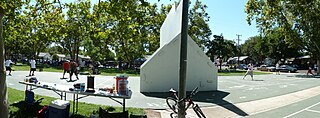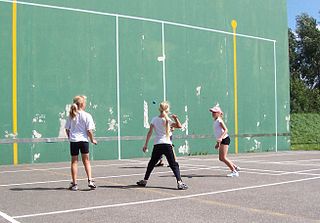Court
The court, called galotxeta (hence the name of this modality), is a 4 walled room, 20m long and 3 m wide. In the middle there's a 1 m high net, it's not tense at all, so its height is a bit shorter on the center. The court is so divided in two sides: the "traure'' and the "rest".
On the rest side, at its right end of the net, there's an 80 cm high flat stone (the "tamboret") used to bounce on it the ball in the service of every doubles game. On the traure side there's a rectangle on the ground next to the left wall, that's where the ball must first bounce after the service of every doubles game. In the case of playing singles the ball must be bounced on a point into that rectangle of the traure.
Also, the walls at the end of every side are called "frontons". The rest frontó is high so every ball returns to the court, but the traure frontó is only 1.5 m high, so public may watch the game in the gallery behind it. In case the ball is sent over the traure wall, the player on the traure must bounce it on the wall and strike the ball on the air (if it already bounced on the ground) or after a first bounce (if it didn't bounce at all).
At the ground of those two frontons there's a 45° bevel, the "tamborí", it allows to raise up low balls with quick and unexpected bouncings.
As for now, all those elements are common to the main Valencian pilota court, the trinquet, being the main difference the size (smaller) and the lack of stairs for the spectators to seat along the left wall. But a unique trait of the "galotxetes" are the "caixonets" ("small drawers"), they are a kind of open doors on every corner. They are used as a direct point place for the sender.
Until recently, this modality was played in the whole comarca of Vinalopó Mitjà, but actually there are court for this modality only in the "Centro Deportivo de Monòver", El Pinós and La Romana, and those last two are not covered. However, the oldest court is in Abdet (Marina Baixa), dated from 1772.
Rules
Galotxetes may be played singles (1 vs. 1) or doubles (2 vs. 2), being the only difference the place to serve from (the point on the traure if singles, and the tamboret if doubles).
The rules are simple, and common to many other handballs: The ball must be struck with the hand and sent to the other side without touching the net, once there it must be sent back after a first bounce on the ground or in the air. The ball may bounce on the walls or on the tamborí as if they were "air". The quinze is won when the opponent cannot throw back the ball, be it because the ball bounces twice on the ground, the ball touches the ball, or the ball is sent to the caixonet.
The scoring system follows the usual scoring system in Valencian pilota: a number of points (commonly, 12) divided in four quinzes: 15, 30, val and joc.

Rugby fives is a handball game, similar to squash, played in an enclosed court. It has similarities with Winchester fives and Eton fives. It is played mainly in the United Kingdom.

Jai alai is a Basque sport involving bouncing a ball off a walled-in space by accelerating it to high speeds with a hand-held wicker, commonly referred to as a cesta. It is a variation of Basque pelota. The term jai alai, coined by Serafin Baroja in 1875, is also often loosely applied to the fronton where matches take place. The game, whose name means "merry festival" in Basque, is called zesta-punta in the Basque Country. The sport is played worldwide, but especially in Spain, France, the U.S. state of Florida, and in various Latin American countries.

American handball, known as handball in the United States and sometimes referred to as wallball, is a sport in which players use their hands to hit a small, rubber ball against a wall such that their opponent(s) cannot do the same without the ball touching the ground twice or hitting out-of-bounds. The three versions are four-wall, three-wall and one-wall. Each version can be played either by two players (singles), three players (cutthroat) or four players (doubles), but in official tournaments, singles and doubles are the only versions played.

Basque pelota is the name for a variety of court sports played with a ball using one's hand, a racket, a wooden bat or a basket, against a wall or, more traditionally, with two teams face to face separated by a line on the ground or a net. The roots of this class of games can be traced to the Greek and other ancient cultures.

Gaelic handball is a sport where players hit a ball with a hand or fist against a wall in such a way as to make a shot the opposition cannot return, and that may be played with two (singles) or four players (doubles). The sport, popular in Ireland, is similar to American handball, Welsh handball, fives, Basque pelota, Valencian frontó, and more remotely to racquetball or squash. It is one of the four Gaelic games organised by the Gaelic Athletic Association (GAA). GAA Handball, a subsidiary organisation of the GAA, governs and promotes the sport.

Valencian pilota is a traditional handball sport played in the Valencian Community. Its origins are not known.
The Circuit Bancaixa, officially Liga Profesional Escala i Corda, is the professional league of Valencian pilota.
The Handball International Championships are yearly held competitions where many countries and regions play the handball sports derived from the Jeu de paume.

Valencian trinquet, or simply trinquet, is the court used in the Valencian Community for two different modalities of Valencian pilota: the Escala i corda and the Raspall.

Escala i corda is the most prestigious variant of Valencian pilota, and the only one apart from raspall to have professional players.

Llargues is the oldest Valencian pilota modality. It is played on the streets, where two teams formed by 3, 4 or 5 players throw each other the ball with the hand try to surpass an imaginary line which changes every game.
The International game is a ball game that is related to many sports derived from and similar to Jeu de paume. It is played in the Handball International Championships by teams from the Americas and Europe.

Raspall is a variant of the handball game Valencian pilota, played mainly in the Valencian regions south to the Xúquer river: the Vall d'Albaida, the Safor, the Costera, the Marina Alta and the Marina Baixa. It is also popular in the Ribera Baixa. It is one of only two variants that have professional players—the other being Escala i corda.
Frontó is a modified Valencian pilota version of the original Basque Pelota game. The name frontó refers both to the game, ball and the playing area. Unlike some of the more popular Valencian Pilota rules, frontó is an indirect game, that is, players do not stand face-to-face but share a common playing area.

The vaqueta ball is the kind of ball used to play some Valencian pilota variants, including Escala i corda, Galotxa and Raspall. Its name derives from the fact that it is made of bull's skin. It has a black colour that tends to become brown as it is used, and is designed to contrast with the white colour of the trinquets' walls.
The 2007 edition of the Handball International Championships was the VII European Championship, organized by the International Ball game Confederation, and was held at the Belgian cities of Nivelles and Buizingen during September 21 and 23.

One-wall handball, also known as 1-wall, wallball or international fronton, is a wall game where the player hits a small rubber ball with their hand against a wall. The goal of the game is to score more points than the opponent. The player then hits the ball, and the ball bounces off the wall and the floor within court lines, if the opponent fails to return the ball, the player scores a point. The sport was created to bring together varieties, such as American handball, Basque pelota, Patball, Gaelic handball, Pêl-Law and Valencian frontó.

A fronton is a two-walled or single-walled court used as a playing area for Basque pelota.
Galotxa is a variety of pilota that is always played in the street, whether artificial or natural, practiced mostly in the northern counties of the Xúquer river.

There is an abandoned Jai alai court in the back of the Hermanos Ameijeiras Hospital, the site of the old Casa de Beneficencia, on Calles Concordia and Lucenas near Calle Belascoain, an area that had been considered in the early part of the city as a place to locate the helpless and the unwanted, it was the edge of the city and the countryside known as the "basurero"; the spectator stands were parallel to Calle Concordia, the front wall of the court faced Calle Lucenas, east in the direction towards Old Havana. The original building has been annexed by five stories of residential concrete construction on the north side along Calle Virtudes. The Havana Jai alai fronton was known as "the palace of screams".











